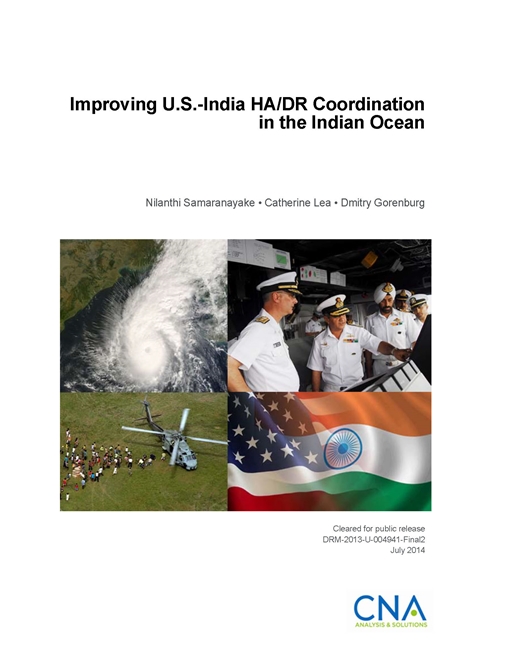In 2012, the CNA Corporation examined the potential for the United States and India to coordinate on providing security assistance and capacity-building in the South Asian littoral countries of the Indian Ocean as a form of security burden-sharing. Of all the functional areas of maritime security analyzed, we concluded that humanitarian assistance and disaster relief (HA/DR) cooperation provides the best chance to advance bilateral naval relations. This is for several reasons. First and foremost, the United States and India are the two major maritime nations operating in the region, and therefore they have the greatest ability to contribute to future HA/DR operations in the region. Second, the Indian Ocean, especially the Bay of Bengal, is prone to regular natural disasters. Third, political sensitivities that otherwise inhibit closer bilateral cooperation tend to diminish in the aftermath of a natural disaster.
This study continues CNA’s analysis of prospects for enhancing navy-to-navy cooperation between the United States and India by focusing on identifying ways for the two navies to coordinate on the provision of disaster relief to Indian Ocean countries. There is a precedent for the United States and India working together during HA/DR operations. After the 2004 tsunami, which killed over 200,000 people in 12 countries, the two navies coordinated their response operations. There is another precedent for operational coordination, outside the realm of HA/DR. Following the 9/11 terrorist attacks, the Indian Navy agreed to an American request to escort U.S.-flagged high-value vessels through the Strait of Malacca under Operation Sagittarius. Offshore patrol vessels INS Sukanya and INS Sharda escorted 24 U.S. vessels between Port Blair and Singapore from April to September 2002. India’s National Maritime Foundation scholar Sudesh Rani called this coordination an “unprecedented step by India that opened a new chapter in maritime relations.” Admiral Walter Doran, who commanded PACFLT during the 2004–2005 tsunami response operations, cites this escort operation as an important development that illustrated the benefits of naval cooperation and paved the way for the two navies to coordinate on HA/DR in 2004.
In addition to the propensity for disasters to strike the Indian Ocean, there are other, broader, factors that may draw the United States and India into a closer HA/DR partnership. The value of U.S.-India cooperation is part and parcel of Washington’s view of New Delhi as a strategic partner, given the countries’ shared democratic political systems, deepening economic linkages, and apprehensions about the rise of China. The decline of the U.S. defense budget also necessitates that the U.S. government seek security burden-sharing opportunities with India whenever possible.
Over the past decade, the U.S. and Indian navies have coordinated operations when their interests have overlapped. The U.S. Department of Defense Report to Congress on U.S.-India Security Cooperation lists four occasions of operational naval coordination: the previous two examples of post-9/11 escorts and the 2004 tsunami responses, plus the 2006 non-combatant evacuation in Lebanon and the ongoing counterpiracy operations in the Gulf of Aden. U.S. cooperation with India is likely to grow as India modernizes its navy and adds capabilities to support improved disaster relief operations and as the frequency of natural disasters, and therefore HA/DR missions, continues to increase in the Indian Ocean.
Download reportCleared for public release
Details
- Pages: 84
- Document Number: DRM-2013-U-004941-Final2
- Publication Date: 7/6/2014
